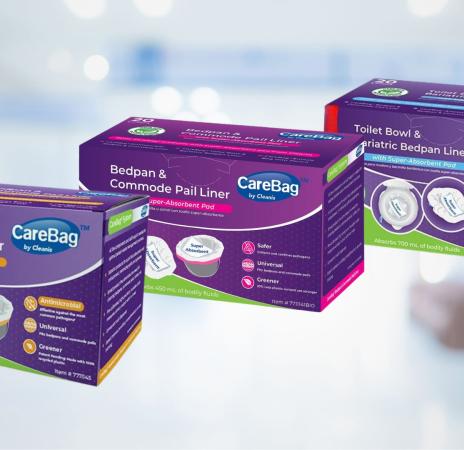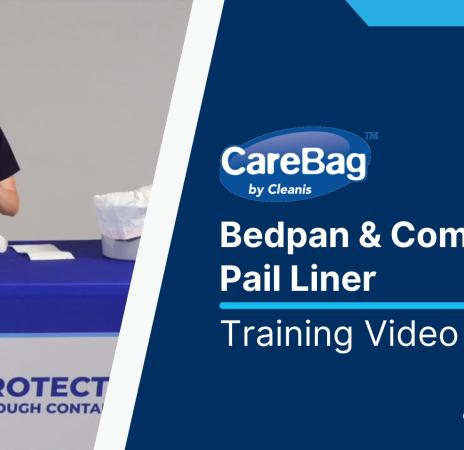An Alternative to Manually Cleaning Bedpans Proves Simple and Effective at Reducing HAIs
Manual cleaning of collection containers — such as bedpans, male urinals, and commode pails — is today's dominant protocol in U.S. healthcare facilities. However, multiple clinical studies demonstrate that this method is ineffective and costly, not to mention unpleasant for those tasked with cleanup.
No matter how dedicated your hospital’s environmental services team is, current cleaning standards simply can’t guarantee complete disinfection. Manual cleaning of bedpans, or other collection containers, unnecessarily exposes patients and caregivers to waste. Spills and splashes — common while bedpans are transported for measuring and cleaning — contaminate floors, counters, and other hospital environments.
Spreading Infection
Managing patient waste is never pleasant, but if the waste is infected it can have a material, detrimental impact on the health of your patients and staff, as well as the hospital’s finances.
C. diff, the most common healthcare-associated infection (HAI), adds a total of 2.4 million inpatient hospital days every year and costs hospitals nearly $35k for every case contracted on site.
|
2.4 million total annual C. diff-related inpatient hospital days1 |
$4.8 billion annual costs for acute care facilities alone2 |
$34,157 average cost per case of hospital-onset C. diff3 |
Even after a manual cleaning, studies show that hospital environments still test positive for C. diff. Even worse, C. diff can survive up to five months on inanimate surfaces extending the risk window for infection.4
A Simple and Safe Alternative
The implementation of single-use, absorbent bedpan liners is a simple change in hospital protocol that immediately contains patient waste and, in conjunction with other best practices, is proven to drastically reduce HAIs, including C. diff.
The use of liners follows the Center for Disease Control & Prevention’s (CDC’s) Hierarchy of Controls, which shows that the most effective way to protect individuals is to physically remove the hazard.5 In the case of Cleanis’ CareBag® Bedpan & Commode Pail Liner with Super-Absorbent Pad, the patient waste is absorbed into the pad, sealed, and disposed of according to hospital guidelines. Containing waste at the sources protects patients, staff, and environments from exposure and potential infection.
A Chatham-Kent Health Alliance clinical study of the CareBag® showed a 61% reduction in infection rates. Further, it greatly simplified the waste managing protocol for nurses caring for infected patients — reducing the number of steps from 20 to nine.6
“CareBag® is such a simple concept that it is surprising that we have not been using this forever,” said Stephanie Blankenship, BSN, RN, CIC Infection Prevention Practitioner at Baylor Scott and White Health in Temple, Texas. “This product truly impacts our staff by making one of the most mundane and potentially messiest parts of our job (toileting our patients) easier, cleaner, and much quicker.”
Quebec, Canada’s Agence d’Evaluation des Technologies et des Modes d’Intervention en Santé concluded that the method is effective and simple to implement. In its 2009 Comparative Analysis of Bedpan Treatment Equipment, the agency wrote:
“Hygienic Bags require little to no infrastructure. This method can easily be implemented in hospitals and other healthcare institutions. (They) allow for the safe disposal of human waste and… would seem to be a promising option at a time of labor shortages and C. diff. outbreak. (They) offer a strong(er) barrier between human waste and the holder and (… since they) do not leave the room (except when the trash is emptied), contamination and spore propagation risks are minimal.”
If your facility does not see a documented reduction of your C. diff or VRE or CAUTI rates after using CareBag® products in the first year of implementation, Cleanis will refund your money.7
1 Clostridium Difficile (C. Diff); Reviewed by LeeAnn Bryant, MHS, RN, CIC (October 01, 2016) https://www.nationaljewish.org/conditions/clostridium-difficile-c-diff
2 Ibid
3 Ibid
4 Fernstrom A., Goldblatt M., “Aerobiology and Its Role in the Transmission of Infectious Diseases.” Journal of Pathogens. vol.2013.
5 The National Institute for Occupational Safety and Health (NIOSH). Centers for Disease Control and Prevention (CDC). https://www.cdc.gov/niosh/topics/hierarchy/default.html
6 E. Vitale, B.Sc. MLT, CIC. “Safer “Pan Handling” to Reduce the Rates of Vancomycin Resistant Enterococci.” Poster.
7 Terms and conditions apply.




